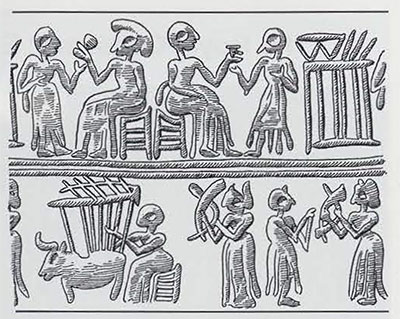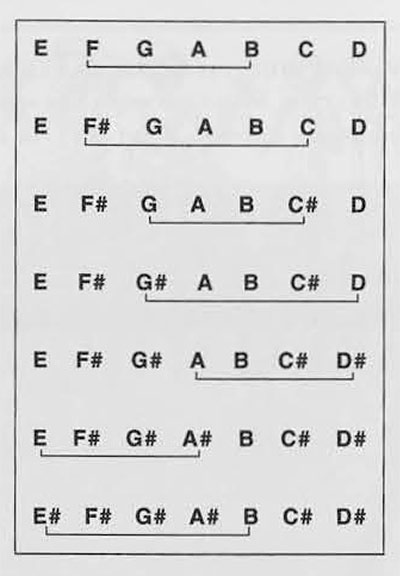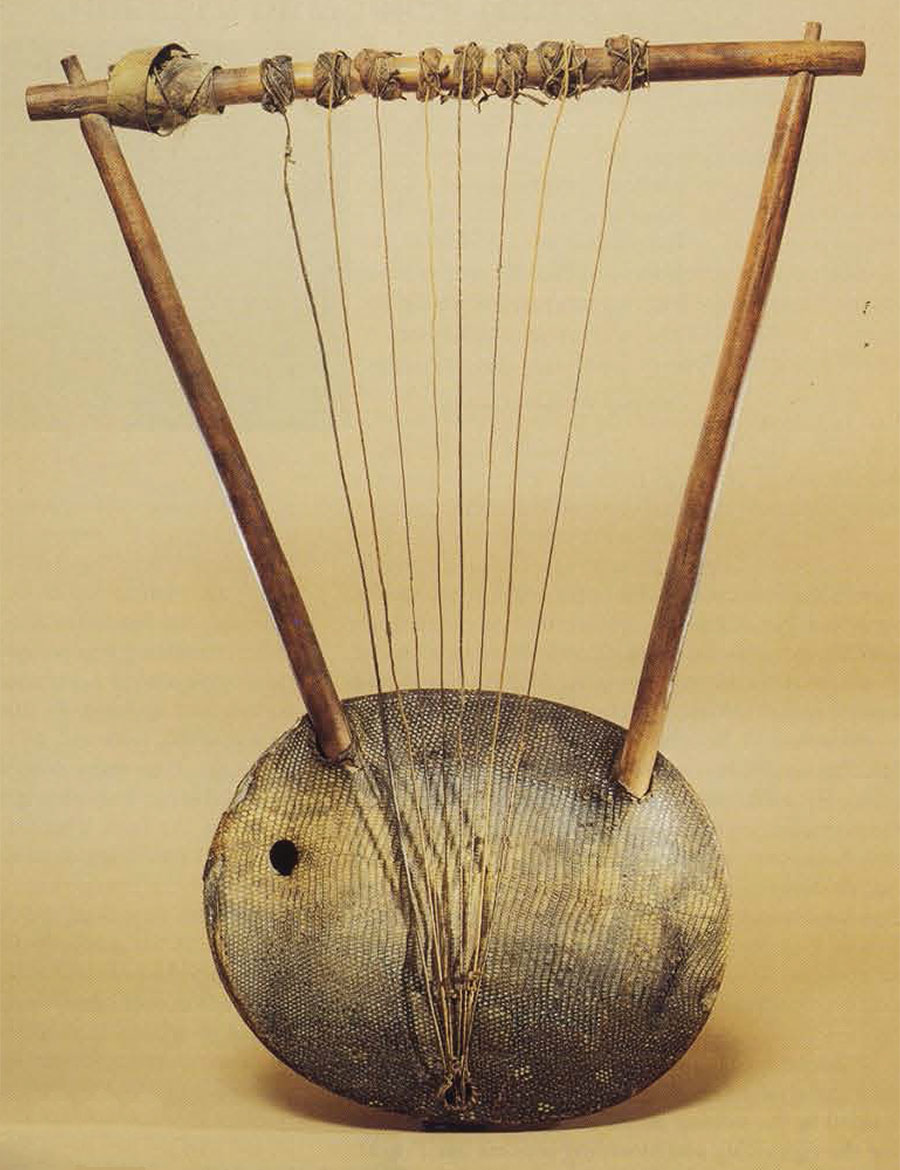The nearly half million cuneiform tablets excavated from ancient Near Eastern sites provide us with ample evidence for the uses of music in ancient Sumer, Babylonia, and Assyria, and among their neighbors in Anatolia, Iran, and Syria-Palestine. Pictorial representations of musical instruments, singers, religious and magic rituals, dancers, acrobats, and sporting events likewise testify to the importance of music in these ancient societies (Figs. 1, 2). And, the discovery of the physical remains of musical instruments at the site of Ur has added a further dimension to our knowledge. Were it not for the eleven stringed instruments recovered at Ur (two harps and nine lyres), we would not have a single actual stringed instrument from ancient Sumer-Babylonia. The Ur graves also yielded a pair of silver wind instruments and a small number of other types of instruments; a few other prehistoric Mesopotamian sites have given us fragments of bone wind instruments.

Museum Object Number(s): B17694A

The original wooden stringed instruments found at Ur were richly decorated or overlaid with gold, silver, copper, lapis lazuli, mother of pearl, and other non-wood materials that did not deteriorate in the earth over the millennia. It is these materials that enabled the excavators to establish the forms and dimensions of the instruments. When the ceilings of the ancient tombs fell in, some of the instruments collapsed together so badly that it was difficult to sort out which pieces went with which (see Fig. 1 in de Schauensee, this issue). As a result of many years of study by archaeologists and museum researchers, we now believe we have correctly separated the different and distinct instruments and improved our assessments of their original sizes. Thus, we now have concrete evidence we can use to replicate these unique lyres and harps (see below).


Museum Object Number(s): B17694B / B17694A
On a lyre, the strings run over a resonating chamber, or soundbox, to a yoke (for more on lyres and harps, see de Schauensee, this issue). The bovine lyre was the most common stringed instrument of the mid-3rd millennium BC in the Near East. Its soundbox is usually in the shape of a realistic reclining or standing bovine. (The heads of some resemble bearded bison.) Other bovine lyre bodies are more schematic: the actual soundbox has a trapezoidal or rectangular shape with a realistic bovine head appended to the front (Fig. 3). The bovine lyre was represented in the graves at Ur by instruments ranging in size from small examples that would have been hand-held to the well-known lyre with the lapis lazuli—bearded bull’s head, the largest of the lyres recovered (Fig. 4 and see cover).
Scales and Tuning in Ancient Music
Among the many cuneiform tablets studied we have been fortunate to have recognized, since 1959, a small number of texts that relate to the tuning and playing of ancient instruments (see map on p. 3). Thus far, cuneiformists have identified ten Mesopotamian tablets (Fig. 5) that contain technical information about ancient musical scales. We now know that by the Old Babylonian period in ancient Iraq (i.e., by at least ca. 1800 BC, or about 850 years after the period of the Royal Cemetery of Ur), there existed standardized tuning procedures that operated within a heptatonic, diatonic system consisting of seven different and interrelated scales (see box with Glossary of Musical Terms). The fact that these seven scales could be equated with seven ancient Greek scales (dating some 1400 years later) quite startled the scholarly community; and the fact that one of the scales in common use was equivalent to our own modern major scale (do-re-mi. . . ) seemed difficult for many to believe (Fig. 6). But research on the part of several cuneiformists and musicologists working together has been strengthened over the years by the steady accumulation of cuneiform tablets that use the same standard corpus of Akkadian terms to designate the names of the musical strings; the names of the instruments and their parts; fingering techniques; the names of musical intervals (fifths, fourths, thirds, and sixths); and the names of the seven scales that derive their nomenclature from the particular interval of a fourth or a fifth on which the tuning procedure starts.
Two of these important technical texts came from the site of Ur, while three others came from another rich Sumerian site, the ancient city of Nippur. It is highly probable that the tuning systems evidenced in the Akkadian language in texts dating from the Old Babylonian to the Neo-Babylonian period (ca. 1800-500 BO had earlier Sumerian antecedents, because many of the technical terms in Akkadian have Sumerian equivalents.
We also know that the Sumero-Babylonian musical system was exported at least as far away as the Mediterranean coast, for the same Akkadian corpus of terms was used for instructions to instrumentalists performing Hurrian cult hymns in ancient Ugarit (modern Ras Sham) in Syria. It is not a stretch of the imagination to suggest that the ancient Greeks did, as Pythagoras said, learn Mesopotamian music theory—together with their mathematics—in the Near East.

Museum Object Number(s): N3354

Playing Sumerian Musical Instruments
The instruments from Ur have a large enough number of strings (several have eleven and one has thirteen) on which to carry out the tuning procedures using intervals of fourths and fifths (the most important in initiating the tuning series) and to accommodate the octave. While we have not identified an Akkadian or a Sumerian word for the octave, it is clear that the octave was known because of the substitution of the number 1 instead of 8 and 2 instead of 9 to represent the octaves of strings 1 and 2. Early Mesopotamian representations of lyres show them with string numbers ranging from three to twelve.
Playable reconstructions of several of the Ur instruments, using coniferous wood, produce rich sounds. (More recent research on the original wood fragments has identified them as boxwood.) The largest lyre (see Fig. 4), having the longest strings, has a register and resonance like that of a bass viol; the medium-sized silver lyre (Figs. 3, 7) has a sound reminiscent of a cello; Puabi’s harp (Fig. 8) sounds rather like a small guitar. Three playable replicas were made in Berkeley, at the University of California, by emeritus professor Robert R. Brown. None of the small lyres from Ur has been reconstructed (as far as we know), but in all likelihood, based on the relative string lengths, they would have had registers similar to that of Puabi’s harp.


What can one reasonably play on these reconstructions? What combination of sounds might resemble ancient Mesopotamian music? The most straightforward and simplest answer would be: the intervals and the tuning procedures, since the tuning text from Ur gives explicit instructions as to which strings to tighten and loosen in order to tune each of the seven scales. But one can attempt, within reason, to do a bit more than that because of the tonality of each scale; that is, once we know the scales, we have a good notion of the kinds of sounds and harmonies that the strings can produce.
What we can never know exactly is how ancient instrumentalists and singers performed. Did they stay on pitch? Did they use a performance style that wavered around the pitch? In the gallery at the University of Pennsylvania Museum where the Ur lyres are on display is a demonstration tape. A common reaction from those listening to it is, ‘This sounds like Western music; surely this cannot be correct! But, in fact, we have no evidence on which to base an assertion that ancient Near Eastern music sounded like modern Near Eastern music. All we have to go on are the intervals and the tunings, which are as “modern” as they are “ancient” (and as universal). Because the structure of the ancient human ear was the same as our own, Mesopotamians heard the consonances of the octaves, the fifths, and the fourths as readily as we do. And their experts could use notes in the overtone series to fine-tune (or even to “temper”) the consonances within a single octave. The existence of instruments with so many strings, and the fact that the intervals and the tuning instructions always use string-pairs or dichords, leads us to believe that the playing of two or more strings at the same time was common, but that single string sounding would also have occurred.

Museum Object Number(s): 30-12-253
Construction Details
In Berkeley we also have a playable replica of the lapis lazuli-bearded lyre that was expertly handcrafted by the late Mr. Eli Richman of Atlanta. His widow, Josephine Richman, donated it to me some years ago for the ancient Near Eastern collections in Berkeley’s Hearst Museum (formerly the Lowie Museum) on the University of California campus. Mr. Richman had viewed an earlier (1970s, not playable) reconstruction of this instrument in the University Museum in Philadelphia and was so awed by its beauty that he made a replica. He used tuning pegs, like guitar or violin pegs, in the top of the yoke to control the tension of the strings, because it was very difficult to tune strings by the use of sticks or rods that work across the yoke of the lyre (this use of pegs is known from the original Puabi harp from Ur). As we have learned from practice on the other replicas, however, it is possible—though at first awkward and difficult—to achieve fine tuning by means of the sticks.
Some representations of lyre yokes show a braided material under the tuning sticks which would have aided in the turning of the strings around the yoke during the tightening and loosening process (see Fig. 1). The boat-shaped stag lyre still preserves traces of the marks made on its yoke by wrappings placed under the strings. Similar materials are found today under the strings of modern lyres from Africa and elsewhere in the world; these can be seen among collections of ethnographic instruments in many museums (see Fig. 4 in de Schauensee, this issue).
In studying the restoration of the boat-shaped stag lyre in the University Museum together with Maude de Schauensee a few years ago, we were puzzled by the narrow rectangular slit through which all thirteen strings must have passed (Fig. 9), seemingly without anything to anchor them or any place at which they could be anchored. Only one logical solution presented itself: each string had to be attached to a toggle which, when placed inside the slit, turned perpendicular to it. When the string was pulled taut around the yoke above, the toggle would be anchored against the edge of the rectangular opening. In that manner, each string could be stretched, fastened, and tuned to the desired pitch. Since the University Museum has a significant collection of African and other lyres, we went together to look at some. As luck would have it, the first three we inspected used toggles to fasten the strings at the very bottom of the instrument (Fig. 10). We were both convinced that we had solved the puzzle of the purpose and function of the small slit in the soundbox of the silver boat-shaped lyre.
We will surely learn more about the construction of ancient instruments as new materials are excavated or as we improve our understanding of known texts and artifacts.

Museum Object Number(s): 42-21-301

* * *
In 1954 I was a prospective graduate student at Penn’s Department of Oriental Studies, and I happened to be visiting the Museum on the day that the Museum’s photographer was taking random photographs in and around the building. He snapped me studying the bullheaded lyre (Fig. 11). Little did I know that ancient Mesopotamian music would eventually form a central part of my Assyriological research from 1948 to 1998, or that the cuneiform texts studied in this 40-year period would lead to the truly exciting recovery of ancient Near Eastern musical scales and tunings.
Glossary of Musical Terms
Heptatonic: Hepta (Greek: seven) seven tone division of the octave. One example of a heptatonic scale is the “do-re-mi” scale.
Third: An interval of three steps; an imperfect consonance which our ears accept as pleasing.
Fifth: An interval of five steps. Like the octave the fifth creates no interference waves. In equal temperament tuning our fifths are slightly smaller than in perfect tuning, not enough to bother most listeners, but enough to allow all of the half-steps to be of equal size and to allow for key changing within a piece.
Tritone: The division of the octave exactly in half. Three (trig-) whole tones. In medieval times this interval was called the devil in music. It was difficult to sing, very unstable, and demanded immediate resolution to a consonant interval.

Tuning: Instruments (pianos, harps, etc.) are tuned according to laws of physics (acoustics). Pythagorean tuning has all the perfect intervals (octaves, 4ths, 4ths) in perfect tune. Equal temperament tuning, which we use in Western civilization today, has modified 4ths and 4ths, but perfect octaves. This tuning is modified to allow for the use of all the various keys composers began to use from the time of Bach onward. Equal temperament tuning allows for equal sized half-steps and for key changes as remote as from C major to F# major with perfect ease. In the Middle East and the Orient there are many other systems, some of which use A tones and other exotic relationships.
Interval: The distance between two tones. On the staff it is counted from the lower to the higher and a number is given to each line and space including both notes.
Octave: The interval with the higher tone twice the frequency of the lower. For example, a = 440Hz, a’ = 880Hz. It is a perfect consonance creating no interference waves. It is also an interval of eight white notes on the piano.
Scale: The division of the octave into some logical or useful series of pitches. The term “scale” indicates ascending by steps of some kind.
Half-step: On the piano keyboard it is the next adjacent tone, 1/12 of an octave.
Whole-step: On the piano keyboard it is the distance between tones two half-steps apart.
Diatonic: The natural scale of five whole and two half-steps arranged like the white keys on the piano keyboard. Each degree of the scale has its own letter name (A, B, C, D, E, F, G).

